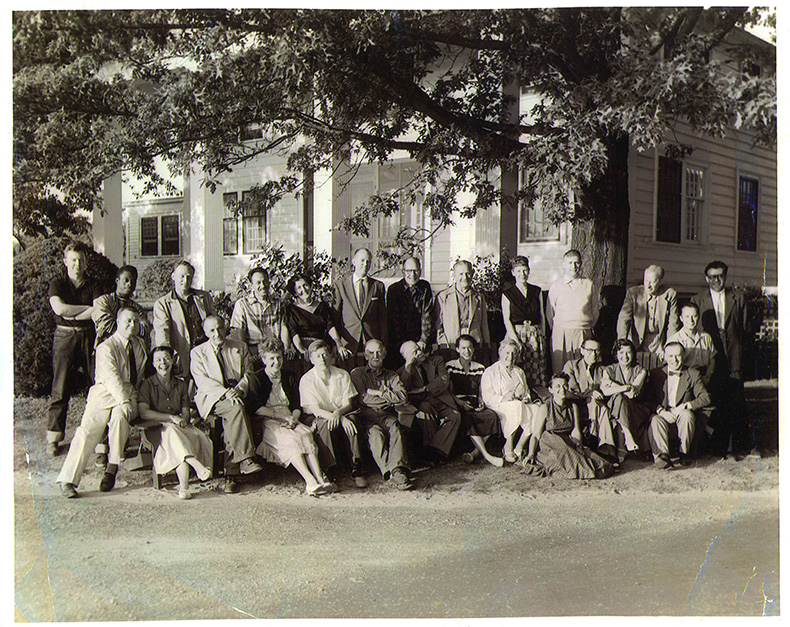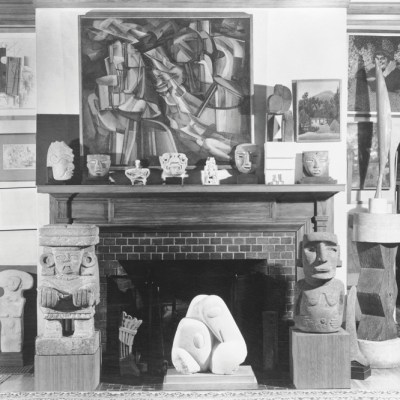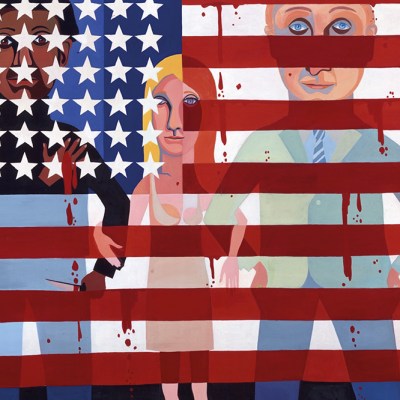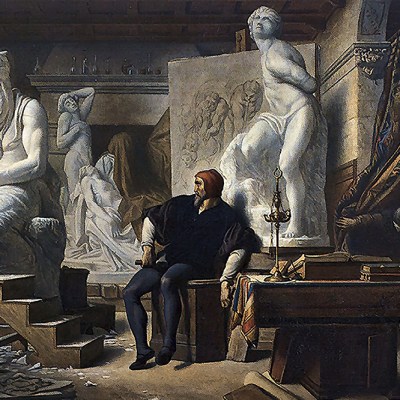For centuries artists have flocked to warmer climes in summer months to take up residencies. They have met other artists and taken their practice out of the normal constraints of their everyday lives. These rites of passage can take place in cabins, seaside studios, forests, uninhabited islands, kibbutz-type communes, historic villas, churches and even barns. There are many residencies around the world, some established, some disruptive, some just quirky, such as the National Parks Art Foundation’s Volcanoes Residency, where artists work between two volcanoes in Hawaii. The clearly named ZIM Integrated Shipping Services’ Container Artist Residency offers the opportunity for artists to live on a working container ship. There is even a residency at the National Science Foundation in Antarctica.
In less demanding surroundings, the history of artists leaving their everyday environment to stay and work in a new and (usually) paid-for location goes back to the Renaissance. The Medici set up a studio for Botticelli in their home; before that, they had invited the young Michelangelo to live with Lorenzo Medici’s own children. In 1666, Louis XIV founded the first large-scale artists’ residency, the French Academy in Rome, as a way for French artists to stay in the Eternal City for three to five years, absorbing the cultural innovations they witnessed on the proviso that they would bring back what they learnt to France. The residency still exists today as the Villa Medici.
The 20th century saw probably the greatest flowering of this tradition in the United States with several notable programmes. MacDowell (previously known as MacDowell Colony) in New Hampshire was founded in 1907, with a mission to take artists away from modernity and the chaos of the metropolis. The residency has hosted over 8,600 artists since its inception, including Milton Avery whose time there overlapped with visiting guest Marcel Duchamp. It was here that the American artist taught the father of Conceptual art how to play pool. Faith Ringgold returned to painting from quilt-making during her time at the residency and, in 1982, made her seminal series Emanon and Baby Faith and Willi. The Skowhegan School of Painting and Sculpture in Maine was established in 1946 for emerging artists, and alumni include Alex Katz and Sanford Biggers, and Helen Frankenthaler was a visiting faculty artist in 1986. Donald Judd’s Chinati Foundation in Marfa, Texas, transformed a town in the middle of nowhere into a serious cultural hub for artists seeking inspiration in its stark landscape. Alumni include Christopher Wool and Rob Fischer.
MacDowell artists-in-residence, 1954. Photo: Bernice B. Perry; courtesy MacDowell

There is a paradox at the heart of many contemporary residencies: the artist is removed to solitude to think and make, while also being placed within a community (the other members of the residency). This is a vital aspect to the residency as artists can exchange ideas, observe and learn from peers in ways that feed back into their own practice.
‘Artists need a test kitchen for their work,’ says Alexander S. C. Rower, the president of the Calder Foundation and grandson of the artist, who established the Atelier Calder residency in the village of Saché, in the Loire region. This residency, at Calder’s former studio, has hosted more than 50 artists since 1989, including Marina Abramovic, Martin Puryear, Tomas Saraceno and Ernesto Neto.
Another American artist who fell for the Old World was Sol LeWitt who relocated to Spoleto in Umbria to work from the Torre Bonomo, a medieval bell tower where he made his seminal wall drawings in 1972. The artist’s daughter Eva runs the Mahler and LeWitt Studios, established in 2010, around artist Anna Mahler and LeWitt’s former studios, inviting artists, writers and curators to live and work together, encouraging interdisciplinary dialogue.
Newer residencies are drawing on historical example for inspiration. In 2019 the collector Aloisia Leopardi established the Castello San Basilio in Basilicata. Following Renaissance models of patronage, she invites artists in to the family home to work. However, as a young collector, she says she wanted to ‘transform the property into a project space’: a place for research, cultural exchange with artists, curators, collectors, collectors and arts professionals, which will gradually involve communities in the surrounding regional villages to experience contemporary art. Her alumni include emerging artists, Oren Pinhassi, Lucy Henshall, Michele Mathison, and Sheida Soleimani, who have all benefited from the ‘deep synergy of past and present’ in the location.
Villa Lena in Tuscany. Photo: Niklas Adrian Vindelev

Meanwhile, in Tuscany, Villa Lena has established itself as a popular and respected artists residency. Through her Villa Lena Foundation, philanthropist and collector Lena Evstafieva has hosted more than 400 artists and alumni over the last decade including Ella Kruglyanskaya, Celia Hempton, and Caragh Thuring. Artists share the premises with guests, eating, drinking, swimming, and enjoying the estate, fostering a spirit of inclusivity. The artists reside in the 18th-century villa, and have a table reserved for them in the hotel dining room to take all meals together, prepared by the in-house chef, Marco Baldeschi, who says that it is his responsibility to ‘keep the artists happy’ by navigating between ‘flexibility and fantasy’ to feed them.
Villa Lena Foundation continues to develop its residency programme and from this year, in partnership with independent curator Mollie E Barnes and the collections management professionals Georgia Powell and Liza Shapiro, to establish She CURAtes The Residency, a programme for artists of all ages who identify as women, in varying stages of their career and mixed educational backgrounds, who would not normally have access to international residencies. They are working to ‘choose artists who need this,’ Powell says. The structure is unique, as each artist attending the residency is championed and funded by a patron who is also responsible for supporting the artist after the residency through advocacy, mentoring and networking, meaning the relationship lasts beyond the programme’s duration. The CURAtes team wanted a ‘return to traditional patronage’ rather than a transactional collecting-based approach. Here, artists and sponsors become part of the same ecosystem because they are ‘custodians’ of the artist’s work and progression. ‘Powered by patrons – it’s as much about involving the patrons into the world of the artist as vice versa,’ says Barnes.
Soumya Netrabile in her studio at Villa Lena. Photo: Eugenia Pavlenko; © She CURAtes The Residency

Given that the gender-based responsibilities of family caretaking are generally weighted against women, it can be extremely difficult for women artists to drop responsibilities and take off for a month. ‘This is my first residency ever,’ says one of this year’s artists, the Indian-born, Chicago-based multidisciplinary artist Soumya Netrabile. ‘I even came to my art career later in life because I had to put family first.’ Since the artist paints pieces that mediate between abstraction and representation, exploring how the body relates to natural terrain, the Tuscan forest surrounding the studios has been significant to her. ‘It’s important to make work that is perceptual and to let myself engage with all the details of the landscape,’ she says. This includes dawn walks in the forest, immersing herself in the bark of the wild pini and ‘collecting as much information as I can from nature to take back to my studio in the US.’
The other inaugural artist in the pilot residency, Precious Opara, is also ‘building a bank of images’ in response to the Tuscan environment. The artist incorporates nature into her practice by visualising the body as an object of nature. ‘A strong body is like a strong tree,’ she says. This is the first time the artist has visited Italy and the residency offers her the opportunity to slow down and think. ‘This is the ultimate setting,’ she says. ‘Nature is non-judgemental, non-constricting.’
The time an artist spends at a residency can be a mini-career or a micro-life. They arrive with nothing but materials and leave with a body of work. However, the newer residencies, with their opportunities for networking, mentoring, funding and building new relationships with more patrons and sponsors, ensures the life of the residency can last beyond the time in the studio in the summer sun.


